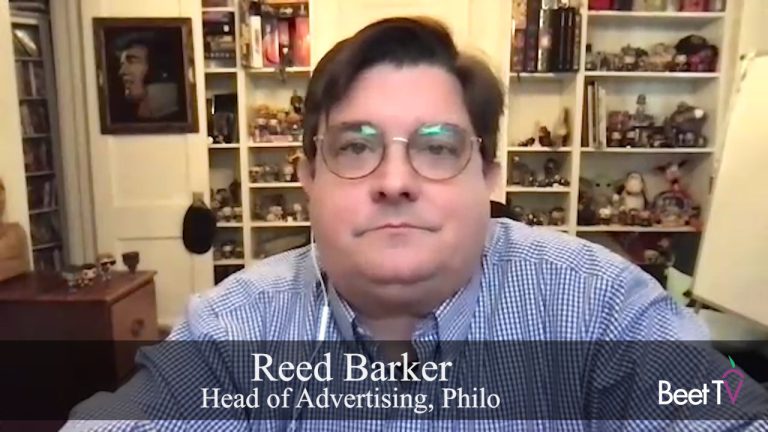
In the new era of ad targeting, the context of contextual matters.
That is to say, contextual targeting can succeed or fail depending on who is tagging the content.
To get the most accuracy possible when making its shows available to buyers, US streaming TV service Philo is turning to what it sees as the ultimate source of truth – the programmers of the channels it carries.
Leaned-in to programmatic
Philo offers 64 channels of linear content – from the likes of Discovery, AMC, Paramount Plus and A+E Networks – for $25 per month, including a cloud DVR and more than 50,000 shows on-demand.
In this video interview with Beet.TV, Philo’s head of advertising Reed Barker explains how exactly the service sells advertising around those shows.
“We’ve leaned completely into programmatic and resellers,” he says. “We just dove deep in there. We didn’t inherit a direct (ad) sales team, so we just didn’t build a direct sales team.
“What that means for the advertisers is, we’re not in a cycle of upfronts … we’re in a place where we can scale as our growth scales.”
The Philo iOS App Now Supports Picture in Picture and Allows AirPlay on Apple TV and Roku https://t.co/G68ipIXx0y
— The Streamable (@TheStreamable) December 1, 2021
Direct to automatic
Speaking of scale, Philo doesn’t provide regular subscriber counts, but disclosed 800,000 subscribers in November 2020 and Barker says the service is “getting close” to 100 million households.
Philo hiked its subscription cost by $5 earlier this year, whilst adding new suppliers including Crackle and AccuWeather.
Unlike traditional TV services, it is common place for streaming and AVOD services to operate almost exclusively as programmatic ad platforms.
Safety in signals
All of which helps Barker offer ad buyers the ability to target against shows – something that depends on identifying and surfacing the right content descriptions as buyable characteristics.
“We’re passing genre and ratings, so the programmatic folks upstream can know ‘this is the type of content my ad is going to go in’,” he says.
Our resident product marketing expert, Vanessa Nguyen, weighs in on how the power of CTV/OTT content targeting will impact the future of advanced TV.https://t.co/PdilP08Hop
— Unruly (@unrulyco) December 1, 2021
But getting there has been a journey. Indeed, it relies on making IAB definitions mesh well with TV industry standards.
“IAB genres are really based on websites,” Barker says. “So, for instance, there’s one called ‘pharma’. Gray’s Anatomy is not a pharma show…
“We had to say, ‘let’s look at what the source of truth is for what the genres actually are’ – that source of truth for us really is the programmer.”
The quest for context
So Philo began using the show genre descriptors provided by TV programmers themselves, funnelling those into programmatic demand-side platforms.
“Other partners … brought their own set of genres to the table and so we’ve worked with them to create a matching table basically to say if it’s a sitcom or that matches to comedy or matches to entertainment,” Barker adds.
All of which speaks to the quest to generate the optimum contextual information that can allow for the biggest targeted ad sale affordance.
For example, a movie studio could advertise against a horror movie TV show, or could reverse that targeting to not appear against any shows with blood and gore, Barker says.
Making the deal
It all works by surfacing the right contextual tags into buying platforms.
“We put them into the VAST calls that we’re sending out to our demand partners,” says Philo’s Barker. “Those can then be grouped by the demand partners in however they want to.
“They’re able to then also see those same signals that we’re sending for genre and rating to be able to group those into targets that we would assign maybe a private marketplace deal or maybe a programmatic direct deal or some other deal that goes across publishers.”
You are watching “Unlocking the Potential of CTV/OTT for Advertisers & Publishers,” a Beet.TV leadership series presented by Unruly. For more videos, please visit this page.